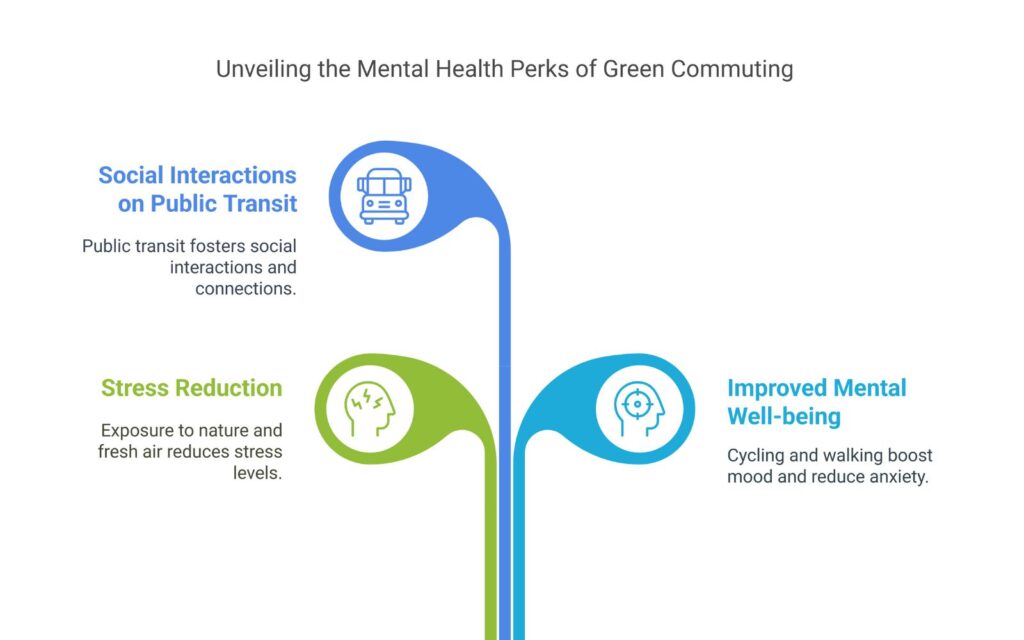Benefits of Green Commuting for Physical Health: A Practical Guide

Have you ever considered how your daily commute can enhance your physical and mental well-being while benefiting the planet? Green commuting goes beyond merely reducing your carbon footprint; it is a sustainable approach that promotes your health, encourages active transportation, and makes your daily routine more fulfilling.
From walking and cycling to public transportation, green commuting offers many benefits, such as improved fitness, stress reduction, and a better quality of life.
In this guide, we’ll explore the benefits of green commuting for physical health, discuss its positive impacts on mental health, and explain how it contributes to a more sustainable future.
Key Takeaways
- Green commuting promotes physical activity: Walking, biking, and other active transportation methods are great for fitness.
- Improves mental health: Spending time outdoors and reducing stress from traffic jams leads to better mental well-being.
- Reduces carbon emissions: Fewer cars on the road means improved air quality and less noise pollution.
- Encourages a healthier planet: Eco-friendly commuting supports efforts to combat climate change and reduce urban heat islands.
- Creates sustainable habits: By incorporating green commuting into your daily routine, you contribute to a more sustainable future.
1. What Is Green Commuting?

Green commuting refers to eco-friendly commuting methods that reduce the environmental impact of human activities. It includes:
- Walking
- Cycling or bicycle commuting
- Public transportation (buses, trains, and trams)
- Carpooling or ride-sharing
- Active commuting, like combining public transit with walking
This approach helps mitigate climate change and promotes physical activity and mental well-being.
2. Physical Health Benefits of Green Commuting

Green commuting is an excellent way to improve overall health. Let’s examine how it supports physical activity and fitness.
a) Walking and Biking for Exercise
Walking and cycling are some of the simplest ways to stay active. These forms of active transportation help you:
- Burn calories during daily commutes.
- Strengthen your muscles and improve cardiovascular health.
- Lower your risk of heart disease through consistent physical activity.
b) Bicycle Commuting Builds Stamina
Cycling is a low-impact exercise that’s gentle on the joints yet effective for building stamina. It also improves mobility and supports joint health, making it suitable for people of all ages.
c) Incorporating Fitness into Your Routine
Green commuting blends exercise with your daily routine, saving time while helping you maintain a healthy lifestyle.
Whether you walk to public transport or bike to work, every trip contributes to better physical health.
3. Mental Health Benefits of Green Commuting

Choosing green commuting methods is beneficial not only for your physical health but also for your mental well-being.
a) Stress Reduction
Green spaces, fresh air, and the opportunity to avoid traffic congestion lead to lower stress levels.
Walking or biking allows for increased exposure to nature, which has been shown to improve mental well-being.
b) Improved Mental Well-being
Activities like cycling and walking help release endorphins, which boost mood and reduce anxiety.
Green commuting also eliminates the stress of being stuck in traffic, providing a calmer start to your day.
c) Social Interactions on Public Transit
Taking public transportation can increase social interactions and reduce feelings of isolation.
These small but meaningful exchanges support overall mental health.
4. Green Commuting Contributes to a Healthier Planet

Eco-friendly commuting benefits the environment in ways that directly impact population health and air quality.
a) Reduces Air Pollution
Fewer cars on the road means fewer carbon emissions and less air pollution. Cleaner air supports better respiratory health and lowers the risks of diseases caused by poor air quality.
b) Fights Climate Change
Green commuting helps reduce greenhouse gases, supporting global climate action and environmental research to create a healthier planet.
c) Lowers Noise Pollution
With fewer cars, there’s a significant reduction in noise pollution, which can contribute to better mental and physical health.
5. Practical Ways to Promote Active Commuting

Want to start green commuting? Here are some simple ways to adopt this sustainable way of living:
- Walking or Cycling: Choose biking or walking for short trips or errands.
- Use Public Transport: Public transportation reduces traffic congestion and gives you more time to relax.
- Try Carpooling: Sharing rides is eco-friendly and builds social connections.
- Leverage Technology: Use apps to find bike-friendly routes or public transit schedules.
- Incorporate Green Spaces: Opt for routes that pass through parks or other natural areas to enjoy additional mental health benefits.
6. Challenges and Future Research: Green Commuting for Physical Health

While green commuting has many benefits, challenges such as safety concerns, lack of infrastructure, and cultural differences can limit its adoption.
Addressing these issues through urban planning, public health policies, and future research is key to promoting eco-friendly commuting.
Researchers from institutions like universities and international journals are already studying the positive impacts of active transportation on population health and the environment.
We can build a more sustainable future by improving research methodologies and focusing on public transport safety and accessibility.
Summary
Green commuting is a powerful way to improve your physical and mental health while reducing your carbon footprint.
Walking, cycling, and public transportation provide many benefits, from improved fitness to stress reduction.
They also support climate action and contribute to a healthier planet by improving air quality and reducing noise pollution.
As green commuting becomes part of your daily routine, you prioritize your physical and mental well-being and help create a more sustainable way of life.
By embracing these positive changes, we can collectively contribute to a healthier, more sustainable future.
Frequently Asked Questions
What Are the Physical Benefits of Green Commuting?
Green commuting encourages physical activity like walking and biking, which improves fitness, strengthens the heart, and lowers the risk of diseases like heart disease.
How Does Green Commuting Support Mental Health?
It reduces stress by avoiding traffic congestion, promotes exposure to green spaces, and encourages social interactions on public transport.
How Does Green Commuting Impact the Environment?
Lowering the number of cars on the road reduces carbon emissions, improves air quality, and fights climate change.
What Are Some Barriers to Green Commuting?
Safety concerns, lack of infrastructure, and cultural differences can limit green commuting.
Future research and improved urban planning can address these challenges.
How Can I Start Green Commuting?
Begin with small steps, such as walking or cycling short distances, using public transit, or carpooling with friends. Over time, these habits can become part of your daily life.




